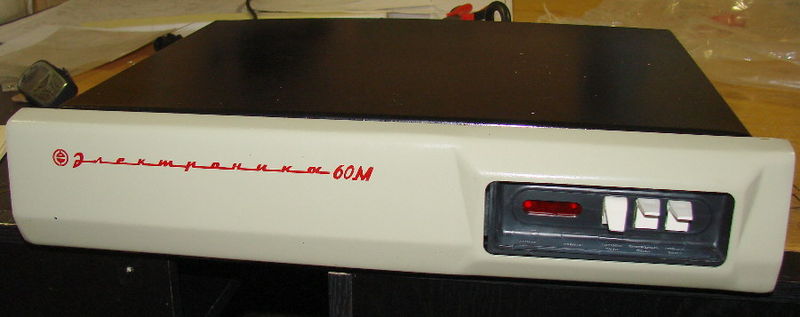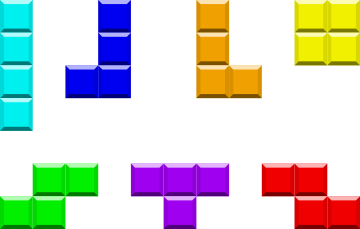
Tetris (Russian: Тетрис, pronounced [ˈtʲetrʲɪs]) is a tile-matching puzzle video game originally designed and programmed by Alexey Pajitnov in the Soviet Union. It was released on June 6, 1984,[2] while he was working for the Dorodnicyn Computing Centre of the Academy of Science of the USSR in Moscow.[3] He derived its name from the Greek numerical prefix tetra- (all of the game's pieces contain four segments) and tennis, Pajitnov's favorite sport.[4][5]

It is also the first entertainment software to be exported from the USSR to the US and published by Spectrum HoloByte for Commodore 64 and IBM PC. The Tetris game is a popular use of tetrominoes, the four element special case of polyominoes. Polyominoes have been used in popular puzzles since at least 1907, and the name was given by the mathematician Solomon W. Golomb in 1953. However, even the enumeration of pentominoes is dated to antiquity.

The game (or one of its many variants) is available for nearly every video game console and computer operating system, as well as on devices such as graphing calculators, mobile phones, portable media players, PDAs, Network music players and even as an Easter egg on non-media products like oscilloscopes.[6] It has even inspired Tetris serving dishes[7] and been played on the sides of various buildings.

While versions of Tetris were sold for a range of 1980s home computer platforms as well as the arcades, it was the hugely successful handheld version for the Game Boy launched in 1989 that established the game as one of the most popular ever. Electronic Gaming Monthly's 100th issue had Tetris in first place as "Greatest Game of All Time". In 2007, Tetris came in second place in IGN's "100 Greatest Video Games of All Time".[8] It has sold more than 70 million copies.[9] In January 2010, it was announced that Tetris has sold more than 100 million copies for cell phones alone since 2005.[10]

Tetris has been involved in many legal battles in regard to rights ownership. In June 1984, Alexey Pajitnov created Tetris on an Elektronika 60 while working for the Soviet Academy of Sciences at their Computer Center in Moscow with Dmitry Pavlovsky, and Vadim Gerasimov ported it to the IBM PC. Gerasimov reports that Pajitnov chose the name "Tetris" as "a combination of 'tetramino' and 'tennis'." From there, the PC game exploded into popularity, and began spreading all around Moscow. The most recent version of this port is available on Gerasimov's web site.[5]

The IBM PC version eventually made its way to Budapest, Hungary, where it was ported to various platforms and was "discovered" by a British software house named Andromeda. They attempted to contact Pajitnov to secure the rights for the PC version, but before the deal was firmly settled, they had already sold the rights to Spectrum HoloByte. After failing to settle the deal with Pajitnov, Andromeda attempted to license it from the Hungarian programmers instead.

Meanwhile, before any legal rights were settled, the Spectrum HoloByte IBM PC version of Tetris was released in the United States in 1986. The game's popularity was tremendous, and many players were instantly hooked; Computer Gaming World called the game "deceptively simple and insidiously addictive".[18]

The details of the licensing issues were uncertain by this point, but in 1987 Andromeda managed to obtain copyright licensing for the IBM PC version and any other home computer system.

For Amiga and Atari ST two different versions by Spectrum HoloByte and Mirrorsoft became available. The Mirrorsoft version did not feature any background graphics while the Holobyte version had a background picture related to Russian themes for each level. Games were sold as budget titles due to the game's simplicity. Spectrum's Apple II package actually contained three diskettes with three different versions of the game, for the Apple II+ and Apple IIe on separate DOS 3.3 and ProDOS 5.25 in (133 mm) diskettes, and for the Apple IIgs on a 3.5 in (89 mm) diskette, none of which was copy-protected: the included documentation specifically charged the purchaser on his or her honor to not give away or copy the extra diskettes.[citation needed]

By 1988, the Soviet government began to market the rights to Tetris, after a promotional trip to the country by Gerald Hicks, the one time United States champion of the game, through an organization called Elektronorgtechnica, or "Elorg" for short. Pajitnov had granted his rights to the Soviet Government, via the Computer Center he worked at for ten years.[19] By this time, Elorg had still seen no money from Andromeda, and yet Andromeda was licensing and sub-licensing rights that they themselves did not even have.[citation needed] In 1988, Sega released an arcade game version of Tetris.[20] This Sega version won the Japanese Gamest Award for Game of the Year in 1989.

In 1996, the rights to the game reverted from the Russian state to Pajitnov himself, who previously had made very little money from the game.[9] In 1996, The Tetris Company was founded, claiming to hold copyright registrations for Tetris products in the U.S.[23][24] and taking out trademark registrations for Tetris in almost every country in the world.[25] They have licensed the brand to a number of companies, and the U.S. Court of International Trade and the U.S. Customs have at times issued seizure orders to preclude unlicensed Tetris-like games from being imported into the U.S.,[26] though bulletins circulated by the U.S. Copyright Office state that copyright does not apply to the rules of a game.[27][28]

In mid-2006,[29] and in late 1997,[30] TTC's legal counsel sent cease and desist letters to Web sites on the basis of Tetris-type games infringing the "Tetris" trademark, trade dress, and/or "look and feel" copyright. Around 2009, TTC and Tetris Holding LLC brought legal action against BioSocia, Inc., on the grounds that BioSocia's "Blockles" game infringed on proprietary rights that were held by TTC and Tetris Holding LLC.[31] On September 10, 2009, the legal case against BioSocia was resolved, with BioSocia agreeing to discontinue making the "Blockles" game available to the public.[31] In May 2010, TTC's legal counsel sent cease and desist letters to Google insisting that 35 Tetris clones be removed from the Android Market.[32] A US District Court judge ruled in June 2012 that the Tetris clone "Mino" from Xio Interactive infringed on the Tetris Company's copyrights by replicating such elements as the playfield dimensions and the shapes of the blocks.[33]


Taken from and references on: http://en.wikipedia.org/wiki/Tetris & http://www.tetris.com/history/index.aspx [06.06.2013]

No comments:
Post a Comment